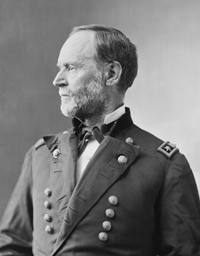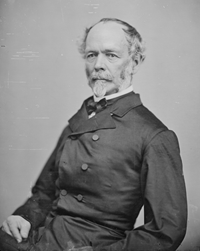

Fayetteville Arsenal
Date of Battle: March10-14, 1865
Location: Museum of the Cape Fear Historical Complex, Downtown Fayetteville (currently only a memorial park on other side of MLK parkway from Museum)
Information: Currently there is only a road marker of this battle, the original farmhouse has burned down and location of any graves are in artillery impact area on Fort Bragg. They can be seen on appointment.

Union Army
MG Hugh J. Kilpatrick
Kilpatrick's Cavalry Division
Strength: 1,850

Confederate Army
LT Gen Wade Hampton and LT Gen Joseph Wheeler
Wheeler’s Cavalry Division and Hampton’s Cavalry Division
Strength: 3,000
Bennett Place and the Final Surrender of the Confederate Army
With Johnston’s Confederates having fled to Smithfield on the night of the March 21 after the Battle of Bentonville. The Federal forces began to pursue the next day the retreating Confederates as far as Hannah's Creek before giving up the chase. Sherman was content to let Johnston escape, fully expecting to have to deal with him again at a later date. But the Confederate withdrawal cleared the way for Sherman to occupy Goldsboro, which was foremost in the general's mind. His army needed rest and provisions, and Sherman also wanted to have the additional forces of J. M. Schofield and A. H. Terry before tangling with Johnston again.
The armies of Sherman, Schofield, and Terry converged on Goldsboro and occupied the town for two and one-half weeks in preparation for the final leg of the campaign.
By early April of 1865, the two armies were again skirmishing with each other from the cities of Hillsborough and Raleigh in northern North Carolina. The Confederates had been trying to reach Virginia to join forces with the army under General Robert E. Lee, when word arrived that Lee had surrendered to General Ulysses S. Grant on April 9th.
Johnston meets with Confederate President Jefferson Davis
The days of the Confederacy were numbered. Seeking to avoid capture in Virginia, President Jefferson Davis arrived in Greensboro on April 11 and summoned Johnston to assess the strength of his army. Though Davis felt the South could continue the war, even if that meant allowing the conflict to deteriorate into guerrilla warfare. The President continued his flight to the Deep South leaving General Johnston to deal with the enormous weight that had thus been placed on his shoulders.
Johnston learning the confirmation of Lee's surrender and knowing that he could not defeat the armies of both Grant and Sherman once they combined and unwilling to launch a guerrilla war that could drench the South in blood for generations, prompted him to confer with Sherman.
The Final Surrender at the Bennett Place
The Confederate general sent a message through the lines to his Union counterpart and then started east on the road from Hillsborough to Durham Station (now the City of Durham). Sherman received Johnston's message and started west from Raleigh on the same road.
The two generals met on April 17, 1865, in an area of open fields and woods. They decided to find a house where they could meet in private. Johnston had passed a cluster of homes so the two generals, accompanied by their cavalry escorts, turned back west. They approached one house but were turned away when the occupants refused to allow a Yankee (Sherman) to enter their home. Thus rebuffed, they continued on to the Bennett Place.
James and Nancy Bennett agreed to let Johnston and Sherman use their home. To give the two generals privacy, the family graciously moved from the house to their log kitchen building, which stood across the yard.
The meeting between the two generals, who had battled each other through the Atlanta Campaign and again in the Carolinas, was given added gravity when Sherman handed General a secret telegram just received from Washington. It announced the assassination of President Abraham Lincoln on April 15th.
Johnston wanted time to consider things and the two men decided to meet again the next day. Returning to their respective forces for the night, they came back to the farm the next day.
There at the Bennett Place, on April 18, 1865, Joseph E. Johnston agreed to surrender the Army of Tennessee.
Sherman had offered Johnston generous terms that he hoped would not just end the fighting, but help restore the Southern states to the Union as peacefully and quickly as possible. Johnston's acceptance, both men believed, would end the war on honorable terms in accordance with Lincoln's vision of "malice toward none, with charity for all."
The agreement, however, was received in Washington by officials irate over the Lincoln assassination and appalled that Sherman would agree to terms that treated the Southerners with such dignity. They rejected the agreement. Personally humiliated and even vilified as a possible rebel himself by some in the North, Sherman notified Johnston of the decision. If the Confederate general did not accept new, more stringent, terms within 48 hours, hostilities would resume.
Ordered by Jefferson Davis to dissolve his infantry into guerrilla bands to continue the fight, Johnston now faced the prospect his surrendering his army a second time. Personally and professionally humiliated, he nevertheless shouldered the responsibility of deciding the future of the South and again agreed to meet with Sherman. On April 26, 1865, the two officers met again at the Bennett Place, where Johnston signed the surrender terms as dictated by Washington.
The surrender included all Confederate forces in North Carolina, South Carolina, Georgia and Florida - 89,270 soldiers in all - and was the largest troop surrender of the Civil War. Other surrenders would follow in Alabama and west of the Mississippi, but the surrender of the Army of Tennessee at the Bennett Place ended for good any prospect of continuing the war in the East. It was at the Bennett Place and not at Appomattox Court House, that the war in the East finally came to a close.
Had the original terms negotiated at the Bennett Place been accepted, the South might well have escaped the horrible days of Reconstruction. It was not to be, however, and the dark cloud of war was replaced by the even darker cloud of military rule that would continue in the southern states for another decade.
Johnston and Sherman became close friends after the war. The latter general, in fact, died of pneumonia after standing bare-headed in a cold rain to show his respect at his former enemy's funeral.